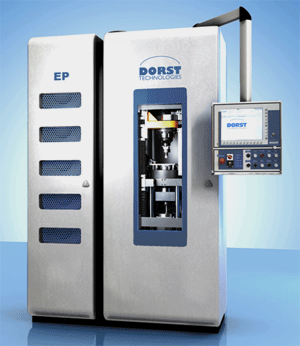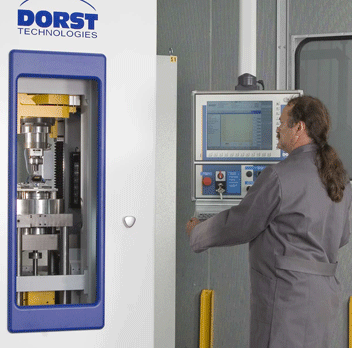Dorst makes the case for electrical servo drive presses
Standard drives used in today’s powder presses are either mechanical, hydraulic or the so-called hybrid drives. The range of application of the different press types varies widely.
Mechanical presses
Mechanical presses are mainly used as standard machines with pressing forces of up to about 4500 kN for the production of “simple” parts in long production runs. These machines have a fixed sequence of operations, all individual movements are interdependent among each other and the upper punch determines the pressing cycle.
This press type is especially characterised by reliability and low energy demand and combines a high production rate with consistent part quality. Operation of the press requires well-trained and highly qualified technicians with extensive knowledge of the functions and operational steps of the machines. The actual setting process and the adjustment of the cycle are complex and time-consuming.
Hydraulic presses
The application of hydraulic presses ranges from small pressing forces up to maximum pressing forces. All movements can be carried out independently of each other and that is the reason why this technology is used for multi- platen systems. The machines are usually equipped with programmable control systems, which are complemented by measuring systems on the machine axes. This way it is possible to record and compensate deviations, which occur during the pressing process.
Hydraulic presses are used for the production of complex and multi-level parts with close tolerances. The closed-loop control ensures stabilised results, even under varying external conditions. The setting process is reduced to a minimum thanks to advanced electronic control systems, supporting software and technical experts. The hydraulic drive requires high energy input and thorough maintenance to ensure reliability during continuous operation.
The electrical servo drive system for presses
Mechanical and hydraulic presses have proven to be successful during many years of extensive use in the production process and under various conditions, however for pressing forces of up to 1200kN there is now an alternative drive technology that incorporates the advantages of both systems.
With the new EP press series from DORST Technologies, the movements of the punches are generated by means of electrical servo-motors and a zero-backlash spindle drive. The system allows the upper punch, die and core rod, to be driven by their own servo-motor, so all movements can be carried out independently of each other.
The EP press series comprises pressing forces from 150kN up to 1200kN and operates according to the die withdrawal process. It is designed for the application of quick-action clamping systems as well as for the installation of die sets. Thanks to this flexibility, tools from existing presses can easily be integrated into the new machines.
The press is equipped with a pre-stressed frame with four columns. The frame is of high rigidity and allows easy access to the press area and tooling from all sides. The positioning and repeating accuracy of the press axes is ±0,001 mm and therefore easily meets today’s requirements for tolerances of compacts.
Press control system
Complete monitoring and programming is carried out by means of the DVS/DCS® (Dorst Visualisation System/Dorst Control System) control system, which has proven to be successful for many years on hydraulic presses. With this system, all hardware and software controls of the electrically driven EP press are available.
The software tool ‘Intelligent Program Generator’ IPG® is an integral part of the control system. On the basis of inputted data on the geometry of the part to be pressed, the IPG® calculates the complete pressing process and generates the appropriate machine program.
The quick reaction of the electrical closed-loop control system and the dynamics of the servo-motors, allow all movements to be carried out with maximum speed and consistently high precision, resulting in an increased number of strokes. Servomotor driven presses, such as the Dorst EP, can therefore match the high stroke numbers achieved by mechanical presses.
Efficient and space saving
Maximum torque, and thus force, are available at any rotational speed and in any position. As a result, the high efficiency factor of the servo motors is being transmitted to the machine as a whole. The energy required for the operation of a powder press with a nominal pressing force of 500 kN amounts to an average amount of about 4 kW (operated at a pressing force of approximately 400 kN and 50 strokes/min). Even a mechanical press, under the same conditions, requires approximately 6.5 kW and the energy demand of a hydraulic press is about three times as much.
The compact design of the drive motors allows for space-saving installation compared to conventional plants. The floor space of an EP50 press requires, for example, only around 70% of the floor space of a comparable 500kN mechanical press. Furthermore, there is the electrical installation, which requires a separate switch cabinet for the drive motors. However, the switch cabinet can be installed independently of the press and thus further away and in a space-saving manner. The operating level is not very high for the most types of the EP press series, so a pit is usually not required.
The machines of the EP press series do not require any auxiliary fluids or lubricants. Hydraulic oil is not required and therefore there is no need for oil changes. In addition to resulting cost savings, this also means that there are no environmental hazards due to leakage of such fluids.
Conclusion
The benefits of electrical servo motor drive presses compared to mechanical and hydraulic press types include:
- The compact design requires very small floor space.
- The direct drive, without intermediate components, leads to a significant decrease of effort regarding maintenance and servicing. The provision of spare parts can be limited to a minimum.
- The machines of the EP press series do not require any auxiliary fluids and lubricants.
- The motors are very silent and have a noise emission less than 65 dB(A).
- The low energy demand decreases the operating costs for the lifetime of the machine.
More information www.dorst.de
- Further reading: Dorst recently won an EPMA 2010 Excellence in Powder Metallurgy Award for their elecetrical servo drive press. Read more here.
News | Articles | Market reviews | Search directory | Subscribe to e-newsletter







